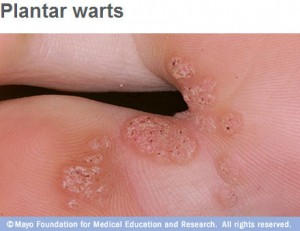-
Tuesday Q and A: Several treatments may be needed to eliminate plantar warts
DEAR MAYO CLINIC: What is the best way to treat plantar warts to ensure they don’t come back? I have them on my feet. At one point, I had them removed with freezing therapy, but they keep returning and even spreading.
ANSWER: Freezing therapy, also called cryotherapy, is the most common and usually the most effective way to treat plantar warts.

But warts can be tough to get rid of completely. Sometimes several cryotherapy treatments are needed to successfully eliminate plantar warts. If the warts are bothering you, make an appointment to have them treated again. Combining cryotherapy with another form of treatment may make it more likely that warts will go away and stay away.
Plantar warts are hard, grainy skin growths that appear on the feet. They usually show up on the balls and heels of the feet, the areas that bear the most pressure. All warts are caused by the human papillomavirus, or HPV. HPV is very common, and there are more than 100 different kinds of the virus. But only a few of them cause warts on the feet. Plantar warts develop when the virus enters your body through tiny cuts, breaks or other weak spots on the bottoms of your feet. Once a plantar wart begins to grow, HPV stimulates the skin to attract and grow its own blood supply. That makes the wart very hearty. If left untreated, warts typically last for one to two years. But most warts do go away eventually. If a plantar wart does not go away over a long period of time, it should be evaluated by a physician because it could be something other than a wart.
Even though plantar warts eventually will resolve on their own, many people still want to get rid of them as soon as possible because they can cause discomfort or pain, and their appearance may be unpleasant. Over-the-counter remedies, such as salicylic acid, are available to treat plantar warts. Repeated applications over several months or more are usually necessary for these treatments to be effective. For plantar warts that do not respond to over-the-counter medications, prescription treatments are an option. The treatment you had, cryotherapy, involves applying liquid nitrogen to the wart, either with a spray or a cotton swab, during an office visit to your health care provider. The chemical causes a blister to form on top of and around the wart. The dead tissue then sloughs off within a week or so. When a plantar wart does not go away after cryotherapy, it is usually because the entire wart was not exposed to the treatment. That can happen when a wart is very thick or the surface area of a wart is large. Another round of cryotherapy is then needed to eliminate the wart completely. Cryotherapy often is most effective when combined with salicylic acid treatments or when the top dead layers of the wart are pared away by a health care provider before cryotherapy is applied. If a plantar wart goes away after treatment and another wart appears, it could be because the area was exposed again to HPV. The strain of HPV that causes plantar warts thrives in warm, moist environments. To help prevent more plantar warts, keep your feet clean and dry. Change your shoes and socks each day. Also, avoid walking barefoot around swimming pools, in locker rooms or in gym showers. Although they can be bothersome and sometimes hard to treat, plantar warts do not pose any serious health concerns, nor do they increase your risk for any other health problems. — Dawn Davis, M.D., Dermatology, Mayo Clinic, Rochester, Minn.







